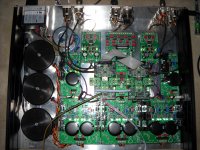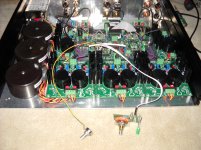The best solution is to stack using the included mezzanine connectors.
I can't stack; I've got 5 IVY boards already stacked on top of each other in order to have 2/8-channel support. The BIII is directly in front of the IVY boards.
I'm using the latest IVY III board.
The signals are differential, so there should not be too much concern about interference, as common-mode cancellation will be on your side. You could use twisted 3-wire groups. Keeping the lengths as short as possible is the main goal.
Thanks Russ!
For confirmation.
To emulate BII
Join:
D1 to D5
D2 to D4, D6
For confirmation.
Is there any possibility TPA might develop a HDMI input module for their DAC's? Perhaps with HDCP, 8 channel LPCM decoding, and Dolby HD or DTS HD decoding capabilities to feed the S/PDIF inputs.
I guess it would need to interface with the input configuration switches to tell the DAC to switch to 6 or 8 channel mode when HDMI is selected as an input.
I guess it would need to interface with the input configuration switches to tell the DAC to switch to 6 or 8 channel mode when HDMI is selected as an input.
Is there any possibility TPA might develop a HDMI input module for their DAC's? Perhaps with HDCP, 8 channel LPCM decoding, and Dolby HD or DTS HD decoding capabilities to feed the S/PDIF inputs.
I guess it would need to interface with the input configuration switches to tell the DAC to switch to 6 or 8 channel mode when HDMI is selected as an input.
No. It requires very expensive licensing fees. Actually, I am 99% sure they would not grant us a license, as preventing exposure of the high-bit-rate data is exactly why they encrypt it.
Actually HDCP might not be necessary. So long as there is a device at the end of the chain that is HDCP compliant (ie the display device), there should be a way to access the audio stream.
I think these guys have done it Dual output 4x2 HDMI Matrix switch with 7.1 Analog Audio output. Full 1080P. Connect HDMI to HDTV and 7.1 Analog Audio to Audio reciever, 1RU mounts included
I think these guys have done it Dual output 4x2 HDMI Matrix switch with 7.1 Analog Audio output. Full 1080P. Connect HDMI to HDTV and 7.1 Analog Audio to Audio reciever, 1RU mounts included
Isn't DSD SACD specific?
This 'matrix switch' uses CS4352 chips (3 I believe). That DAC supports I2S input. So I'd assume the LPCM is stripped from the HDMI, then decoded into I2S (48KHz - 192KHz), and then fed into the CS4352.
It might just be possible you know.
This 'matrix switch' uses CS4352 chips (3 I believe). That DAC supports I2S input. So I'd assume the LPCM is stripped from the HDMI, then decoded into I2S (48KHz - 192KHz), and then fed into the CS4352.
It might just be possible you know.
Dolby HD requires a license from Dolby Labs. (Apply for a Dolby Consumer or Professional License)
DTD HD requires a license from DTS. (Corporate | Press Releases, History, Management | DTS (Inc) and DTSI)
HDCP is definitely required, as the HDMI source encrypts the audio data, so if you want access to that, you need to license that as well. (Digital Content Protection)
Than, for HDMI in general, you have the $10,000 annual fee and a per unit fee. (HDMI :: Manufacturer :: Becoming an Adopter :: Terms)
Really, it's not like we haven't thought about it, or discussed it a thousand times.
We would really like to offer a full-bandwidth audio solution over HDMI, but it's not possible without obtaining some expensive licenses, then violating the agreements by exposing the high-bandwidth data.
Read Exhibit C, Section 3.3 here: http://www.digital-cp.com/files/sta...HDCP License Agreement0831_2011_clean _2_.pdf
DTD HD requires a license from DTS. (Corporate | Press Releases, History, Management | DTS (Inc) and DTSI)
HDCP is definitely required, as the HDMI source encrypts the audio data, so if you want access to that, you need to license that as well. (Digital Content Protection)
Than, for HDMI in general, you have the $10,000 annual fee and a per unit fee. (HDMI :: Manufacturer :: Becoming an Adopter :: Terms)
Really, it's not like we haven't thought about it, or discussed it a thousand times.
We would really like to offer a full-bandwidth audio solution over HDMI, but it's not possible without obtaining some expensive licenses, then violating the agreements by exposing the high-bandwidth data.
Read Exhibit C, Section 3.3 here: http://www.digital-cp.com/files/sta...HDCP License Agreement0831_2011_clean _2_.pdf
Last edited:
Yikes! Well thanks for the info. I don't mean to go over old ground, I'm just sure there must be a way as it seems other small manufacturers are offering HDMI solutions.
It seems like these manufacturers aren't bothering with the licences or fees. I don't know how else they could sell their HDMI products so cheaply.
It seems like these manufacturers aren't bothering with the licences or fees. I don't know how else they could sell their HDMI products so cheaply.
when hooking up singleS/PDIF bIII input , no jumpers,what input do I hook to? and how does
the 9018 know?
the 9018 know?
Hello guys,
Unfortunately I still can not start listening to music!
As I said I read from cover to cover the BIII DAC Integration Guide and have configured the system as I understand.
I used the following: 4-Channel S/Pdif-4input board*Sidecar*two BuffaloIII modules*one Legato 3* two Ventus HA*2-bit rotary switch*volume control.
1. I followed the instructions on page 21, "Sidecar and S/PDIF-4 input board integration", so I have not mounted JPCM1,JPCM2,JPCM3,JDSD1,JDSD2 on both BIII modules.
"Solder the 24-pin unshrouded header for the EXT_IO connector (EXT_IO, 12) in place. This allows you to connect the switch for the input selection of the S/PDIF-4 Input Board"(page 21)???? . More explanations here!
2. For dual mono I followed the instructions on page 23 step by step for both channel.
3. DIP switch setings:
SW1: 1 - off
2 - off
3 - off
4 - off
5 - off
6 - off
7 - off
8 - off
SW2: 1 - off
2 - off
3 - on
4 - off
5 - off
6 - off
7 - off
8 - on
These settings must be made on both BIII in dual mono? On right channel I remove the on-board firmware controller from the board, jumper on ADDR, jumper on R7!
"Only a DAC board with both the firmware controller and L5 in place and R7 not shorted will respond to the DIP switches"!!! page 23.
Can someone give me advice? Russ White, Brian Donegan, LeonvB,...?
Would have been ideal to do one diagram for BIII Dual mono one Legato!
Thank You!
Unfortunately I still can not start listening to music!
As I said I read from cover to cover the BIII DAC Integration Guide and have configured the system as I understand.
I used the following: 4-Channel S/Pdif-4input board*Sidecar*two BuffaloIII modules*one Legato 3* two Ventus HA*2-bit rotary switch*volume control.
1. I followed the instructions on page 21, "Sidecar and S/PDIF-4 input board integration", so I have not mounted JPCM1,JPCM2,JPCM3,JDSD1,JDSD2 on both BIII modules.
"Solder the 24-pin unshrouded header for the EXT_IO connector (EXT_IO, 12) in place. This allows you to connect the switch for the input selection of the S/PDIF-4 Input Board"(page 21)???? . More explanations here!
2. For dual mono I followed the instructions on page 23 step by step for both channel.
3. DIP switch setings:
SW1: 1 - off
2 - off
3 - off
4 - off
5 - off
6 - off
7 - off
8 - off
SW2: 1 - off
2 - off
3 - on
4 - off
5 - off
6 - off
7 - off
8 - on
These settings must be made on both BIII in dual mono? On right channel I remove the on-board firmware controller from the board, jumper on ADDR, jumper on R7!
"Only a DAC board with both the firmware controller and L5 in place and R7 not shorted will respond to the DIP switches"!!! page 23.
Can someone give me advice? Russ White, Brian Donegan, LeonvB,...?
Would have been ideal to do one diagram for BIII Dual mono one Legato!
Thank You!
Attachments
Have you already tested the individual modules?
DIP settings are done on the board with the on-board firmware.
Dual mono with 1 I/V stage is not a standard configuration. I'm already at 52 pages covering just the basics, it's simply impossible to document everything you could do with the boards.
DIP settings are done on the board with the on-board firmware.
Dual mono with 1 I/V stage is not a standard configuration. I'm already at 52 pages covering just the basics, it's simply impossible to document everything you could do with the boards.
- Status
- Not open for further replies.
- Home
- More Vendors...
- Twisted Pear
- Buffalo III - flexibility without compromise.

